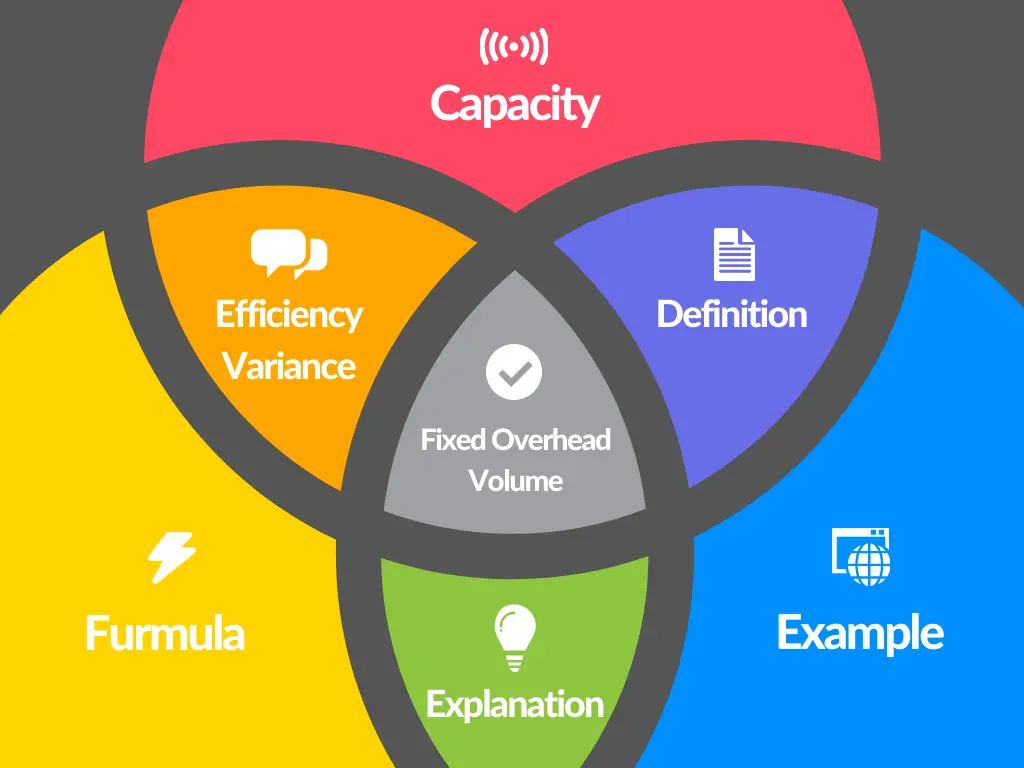Definition:
- Fixed overhead volume variance: It is defined as the difference between fixed overheads actually incurred and fixed overheads applied to units actually produced.
- Fixed overhead capacity variance: It is the difference between budgeted fixed overheads and fixed overheads applied to the number of hours worked.
- Fixed overhead efficiency variance: It is the difference between actual hours worked and the number of hours actual production should have taken multiplied by the standard fixed overhead absorption rate.

Formula:
- Fixed overhead volume variance = (standard hours * fixed overhead absorption rate) – budgeted fixed overheads
- Fixed overhead capacity variance = (Budgeted hours – Actual hours) * Budgeted fixed overhead absorption rate per hour
- Fixed overhead efficiency variance: (actual hours – standard hours of actual output) * standard fixed overhead absorption rate
Explanation:
Fixed overhead total variance can be divided into two separate variances i.e. fixed overhead spending variance and fixed overhead volume variance.
Fixed overhead volume variance is further divided into two more components; fixed overhead capacity variance and fixed overhead efficiency variance.
Fixed overhead variances measure the over-or under-absorption of fixed overheads.
It actually compares the budgeted fixed overheads to the actual fixed overheads incurred by the company and measures how much of the expected fixed overheads were recovered (under or over).
- Fixed overhead volume variance measures the under-or over-absorption of fixed overheads due to deviations in the budgeted production and actual production. Since fixed overheads do not vary as the output varies a material’s fixed overhead volume variance must be due to a new unpredicted expense. For example, an unexpected investment in a factory plant due to increased demand for the product would increase the annual depreciation expense resulting in a higher depreciation expense than expected.
- Fixed overhead capacity variance represents the under-or over-absorbed fixed overheads occurring due to a difference in planned labor working hours and the number of labor hours actually worked. It accounts for the hours that the laborers could have worked but didn’t work or were overworked. This may be caused due to a labor strike, shortage of labor/overtime work performed by the laborers, plant and machinery breakdown, etc.
- Fixed overhead efficiency variance quantifies the efficiency of labor i.e. it analyzes how much time it actually took for the labor to complete one unit as compared to the standard time of completing one unit. A fixed overhead efficiency variance may arise due to an unexpected increase in inefficiency. It may arise if a company increases the break-time for employees so that they could relax more resulting in labor being more efficient, an introduction of a bonus or commission would work as a motivation for efficient work, an improvement in the working environment, labor strike, machine breakdown, etc.
Analysis:
- A fixed overhead volume variance would be favorable when the applied fixed overheads are higher than the budgeted fixed overheads. Applied fixed overheads are higher due to increased production as compared to the budgeted production indicating efficient use of capacity. An unfavorable fixed overhead volume variance occurs when applied fixed overheads are lower than the budgeted fixed overheads for reasons like an inefficient use of capacity.
- A favorable fixed overhead capacity variance arises when fixed overheads are over-absorbed due to more hours worked than the budgeted capacity. An unfavorable overhead capacity variance occurs when fixed overheads are under-absorbed i.e. labor worked inefficiently even less than the budgeted capacity resulting in an adverse effect on the financial statements of the company.
A fixed overhead efficiency variance is favorable when the input labor hours for the actual production are less than the standard hours i.e. more finished goods were produced in lesser time.
However, a fixed overhead efficiency variance is adverse or unfavorable when the input labor hours for the actual production are more than the standard hours.
What is Fixed Overhead Capacity Variance?
Fixed overhead capacity variance measures the difference between the actual and expected output based on fixed costs incurred in production.
It is an essential indicator of how efficiently a company uses its resources and a way to evaluate any changes that may have been made to improve efficiency.
A fixed overhead capacity variance will be calculated by subtracting the actual output from the expected outcome using pre-determined assumptions such as fixed costs and assigned values for each product or service being produced.
This difference can then be compared to industry norms or previous periods to interpret its implications for the organization.
If it is positive, this means there were fewer costs than expected and more profitable than initially assumed; if it is negative, it indicates more expenses than expected, making it less suitable than initially projected.
The information gathered in this calculation can provide valuable insight into an organization’s efficiency, allowing managers to identify areas where improvements could be made.
This analysis can also be used to benchmark against competitors or other sectors to see how they are performing relative to one another.
By understanding these numbers, companies can strive for maximum efficiency and profitability in their operations.
